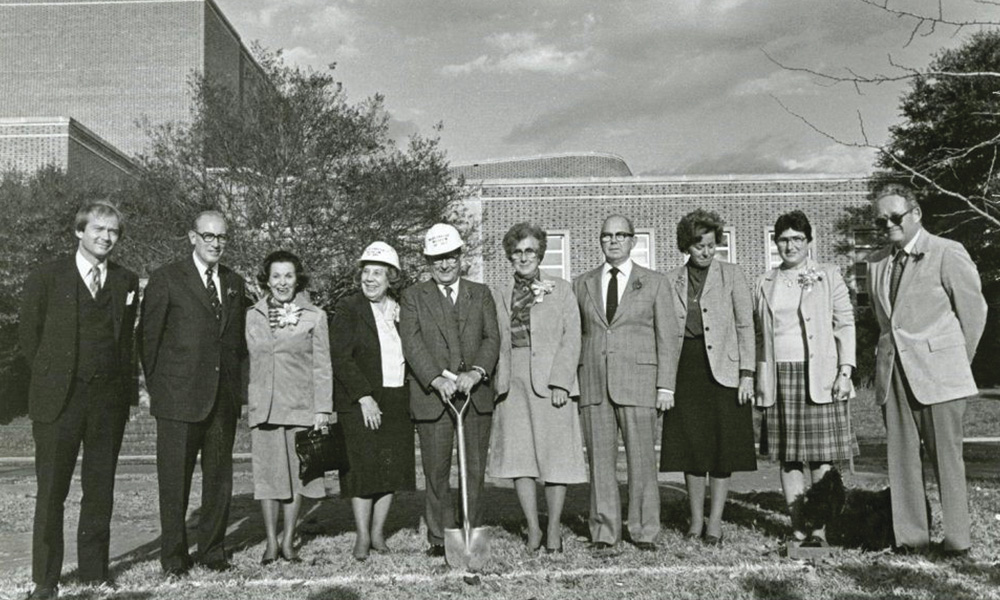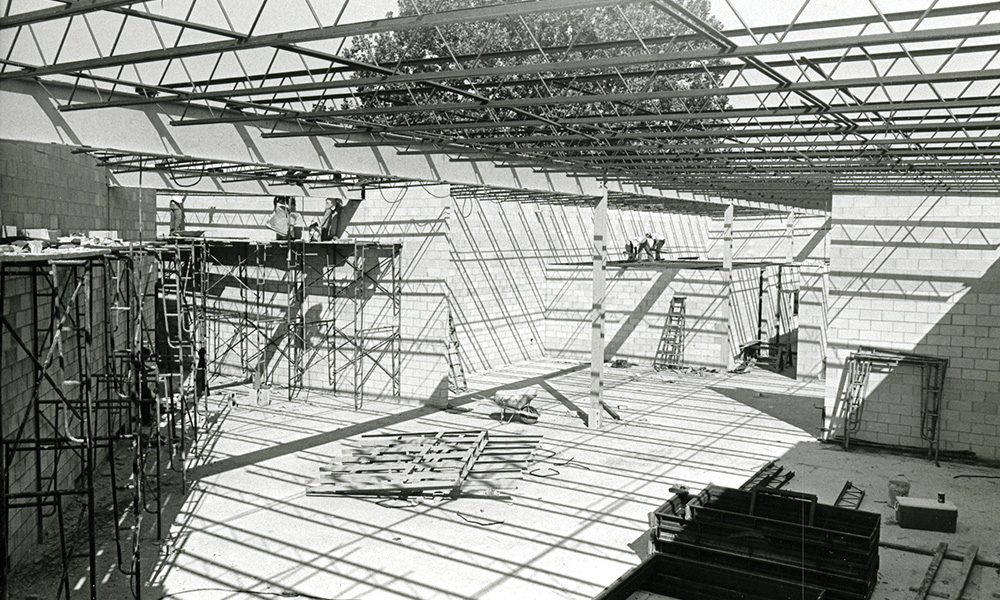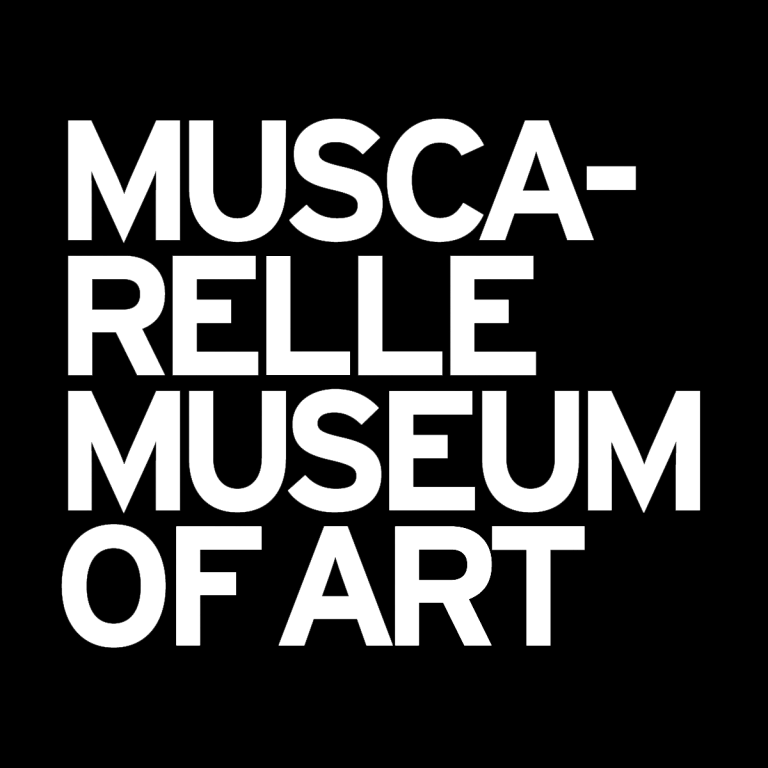BUILDING UPDATE: LOOKING BACK
Fall 2022

By Melissa Parris, Deputy Director — Collections, Exhibitions & Operations
As the Muscarelle Museum of Art approaches its 40th year and grows closer to breaking ground on the building expansion, we would like to acknowledge the contributions of the many who helped bring us to where we are today.
Built in two phases, the Muscarelle opened the doors for Phase I in 1983. This was accomplished after numerous years of planning and gaining traction with a wide group of stakeholders. The earliest advocate for a campus museum was Professor Miles Chappell, who surveyed what was called the “College Art Collection” in the early 1970s. Chappell’s project revealed that over nearly 300 years, the university had amassed a sizeable collection of art, and there was a clear need for a museum to preserve and protect them.
W&M President Thomas A. Graves HON ’15 found the arguments supporting the formation of a university museum compelling and made its construction a centerpiece of his administration. President Graves and Dean J. Wilfred Lambert ’27, LHD ’81 recruited Joseph L. Muscarelle, Sr. ’27 and his wife Margaret to be the primary benefactors of the new museum, and their generous support helped move the project forward. Subsequent endowments from the Muscarelle family helped support museum operations and scholarships for William & Mary students. With the Muscarelle’s patronage and additional funds from The Kresge Foundation, Philip Morris Incorporated, Lucille Godfrey Quattlebaum ’38, and Alexander M. Quattlebaum, a campus museum became a reality.
The award-winning architect Carlton Abbott was selected to design the Muscarelle Museum of Art, and ground was broken on November 6, 1981. The first phase was comprised of two galleries named in memoriam, including The Edythe C. and Ralph M. Sheridan Gallery funded by Jeanne ’39 and Gilbert ’34 Kinnamon and the adjacent Enid W. and Bernard B. Spigel Gallery funded by Frederick ’48 and Lucy S. Herman ’47 with support from their daughter Fredrika Herman Jacobs and their son Bernard L. Herman ’73.

Glenn Lowry (current Director at the Museum of Modern Art, New York) served as the inaugural Museum director and oversaw the construction, which included a multi-colored solar wall designed by Washington Color School artist Gene Davis. The first phase also included an administrative office and art storage necessary to house the historic collection as well as new gifts of art from Gertrude Perrin and Fred and Lucy Herman, among others. Along with past efforts from Earl Gregg Swem and Miles Chappell, Louise Lambert Kale HON ’09 was the Museum’s first member of the curatorial staff, serving as registrar from 1983 through 1995. Kale’s steadfast dedication was integral to the launch and operations of the new Museum.
In 1987, the Museum underwent an expansion to nearly double its original footprint. At this time, Mark Johnson succeeded Glenn Lowry as Director and oversaw the expansion as well as the Museum’s first accreditation with the American Alliance of Museums. In Phase II, June S. and Joseph H. Hennage funded the build-out for the office of the Director. The Herman Graphic Arts Study Room, in recognition of the generosity of Lucy Spigel Herman and Frederick Herman, was established. A second floor with exhibition galleries was created, including the Cheek Gallery, in recognition of the generosity of Mary Tyler Cheek and Leslie Cheek, Jr., who served as the founding chair of the fine arts department in 1936. The central, larger Graves Gallery was named in honor of Zoë Wasson Graves and Thomas A. Graves, Jr., who served as W&M president from 1971 – 1985, both of whom actively supported the Museum’s founding. Later funding for the third gallery, now the Gene A. ’52 and Mary A. Burns Gallery, was named in loving memory by their son William A. Burns, daughter-in-law Jill Eden Burns, and son Andrew A. Burns.
While the second phase created additional office and art storage spaces, the Muscarelle has now outgrown the 1987 addition. At the time of its initial opening in 1983, the Museum had a staff of three and an art collection of just under 1,000 works. Since that time, the collection has grown to over 6,500 works and hosts a team of 16, working to support the academic mission of the university and respond to the cultural needs of both the William & Mary and regional communities.
Beginning around 2008, when the need for additional art space on campus was recognized, a feasibility study for an expanded arts quarter was conducted. With the support of President W. Taylor Reveley, III HON ’18, LHD ’18 and the Muscarelle Museum of Art Board, the study helped to energize the aspirations of numerous alums who will forever be part of the history of the Muscarelle Museum of Art.
With a significant leadership naming gift from Martha Wren Briggs ’55, a long-time supporter and friend of the Museum, the concept of an expanded facility became manifest. Our efforts were bolstered by important commitments from Jane ’56 and Jim ’57 Kaplan, Joseph and Sharon Muscarelle HON ’16, Patty and Carroll ’62 Owens and The Owens Foundation, and Henry “Hank” Wolf ’64, JD ’66, LLM ’73 and Dixie Wolf HON ’10. Many others have answered our call for support, and it is with these collective commitments, we look forward to breaking ground in early 2023.
The renewed Museum will include additional gallery space, a state-of- the-art study center for works on paper, a hall for special functions, expanded storage areas for the collection and new staff offices. The combined new facility will total approximately 59,000 square feet, with a new entrance through a central atrium that bridges between the old wing and the new wing, accessible from both Jamestown Road and the internal campus. The expanded Museum will help to foster curiosity and the love of arts for generations to come. This kind of impact is borne out of the kindness of our donors, and we thank all, named and unnamed here, past and present.
